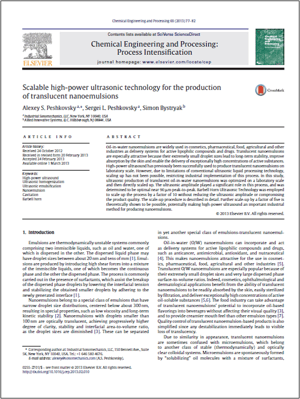Simon Bystryak, Alexey S. Peshkovsky, Rasa Santockytea. Chemical Engineering and Processing: Process Intensification, Volume 99, July 2015, pages 99-106.

Ultrasonic disruption of yeast and other microbial cell cultures is commonly used for laboratory-scale protein preparations because it is rapid, efficient and simple to use compared to such methods as high-pressure homogenization (HPH) and bead milling. Lysing by sonication is also more effective than other cell disruption methods for the recovery of periplasmic, membrane-bound, or insoluble recombinant
proteins. Until recently, however, due to amplitude limitations of conventional-design pilot and industrial-size sonication equipment, ultrasonic cell disruption was only feasible on the laboratory scale. In this study, we show that Barbell Horn Ultrasonic Technology (BHUT) can be successfully used for the disruption of Sacharomyces cerevisiae (S. cerevisiae) cells on a large scale. In particular, we show that
by using pilot-scale BHUT-based equipment, total protein and alkaline phosphatase can be efficiently extracted from S. cerevisiae cells, achieving about an order of magnitude productivity increase factor with respect to laboratory-scale results. Since the size of BHUT-based ultrasonic processors can be increased
further, ultrasonic cell disruption now has the ability to develop into a valuable commercial-scale method, potentially superior to HPH and bead milling techniques in this area of application.
Industrial Sonomechanics is a R&D, equipment design and process consulting firm, specializing in high-power ultrasonic technology for liquid treatment. Our mission is to help businesses implement their ultrasound-assisted processes on lab, pilot and industrial scales.
[fa icon="phone"] 786-233-9255
[fa icon="envelope"] contact@sonomechanics.com
[fa icon="home"] 7440 SW 50th Terrace #109, Miami FL 33155